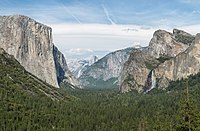JA:Tag:protect_class=2
 |
| 説明 |
|---|
| 国立公園 |
| グループ: 参照 |
| 適用できる要素 |
| 依存するタグ |
| 関連項目 |
| 状態:事実上の標準 |
| ツール |
protect_class=2はboundary=national_parkやboundary=protected_areaの地物に追加することで、IUCNカテゴリII (National Park)であることを示します。
国立公園(![]() national park)は、(行政境界
national park)は、(行政境界 boundary=administrative がそうであるように)政府によって制定された比較的広い領域で、人間のレクリエーションと、その領域の自然環境や文化遺産を保護するためのものです。野生生物や景観を保護するため、通常は人間の活動、とりわけ開発行為への規制が伴います。国立公園はしばしば「~国立公園」のように命名されています。
Category II: Large natural or near natural areas set aside to protect large-scale ecological processes, along with the complement of species and ecosystems characteristic of the area, which also provide a foundation for environmentally and culturally compatible spiritual, scientific, educational, recreational and visitor opportunities.
— iucn.org
例
IUCNカテゴリIIに該当する国立公園の例:
 Plitvice Lakes National Park, Croatia
Plitvice Lakes National Park, Croatia Serengeti National Park, Tanzania
Serengeti National Park, Tanzania Torres del Paine National Park, Chile
Torres del Paine National Park, Chile Uluṟu-Kata Tjuṯa National Park, Australia
Uluṟu-Kata Tjuṯa National Park, Australia Yosemite National Park, USA
Yosemite National Park, USA Zhangye National Geopark, China
Zhangye National Geopark, China
タグ付けに関する注記
国立公園の境界は、古いboundary=national_parkか、新しいboundary=protected_areaのいずれかとともにタグ付けします。
Protected Area Categories
The protected area categores in OpenStreetMap were inspired by IUCN protected area categories, or IUCN protected area management categories, the categories used to classify ![]() protected areas in a system developed by the
protected areas in a system developed by the ![]() International Union for the Conservation of Nature (IUCN).[1][2]
International Union for the Conservation of Nature (IUCN).[1][2]
The IUCN has developed the protected area management categories system to define, record, and classify the wide variety of specific aims and concerns when categorising protected areas and their objectives. In addition to publishing conservation category definitions, IUCN also maintains the Green List, a listing of a small number of conservation areas that are certified by the IUCN for their conservation practices.
The IUCN categorisation method is recognised on a global scale by national governments and international bodies such as the ![]() United Nations and the
United Nations and the ![]() Convention on Biological Diversity.[3]
Convention on Biological Diversity.[3]
Unfortunately, the IUCN website appears to be copyright-protected, so the list of protected areas cannot be copied into OpenStreetMap.
Sources of IUCN Category Designations
Below is a non-exhaustive list of sources that mappers can consult when determining what which protect_class=* value to assign:
| Country | License | Source |
|---|---|---|
| United States | PD | U.S. Geological Survey, Science Analytics and Synthesis, Gap Analysis Project (GAP): Protected Areas Database of the United States 2.0 |
IUCN 75% Rule
Note that the IUCN definitions include the "75% rule", which says that an area may be categorised under one of the IUCN definitions if 75% of the area meets the category definition. This allows for a small amount of non-conservation land to exist within a larger tract, for example, to allow for visitor facilities.
protect_class=* values
| Criteria | protect_class=*
|
|---|---|
| Human visitation is so strictly controlled that the area is suitable as a reference for scientific study. | protect_class=1a
|
| Human visitation is permitted for those prepared for self-reliant travel such as on foot or by boat. The area has no established visitor infrastructure. The area is large enough that a journey to the interior represents a significant undertaking that requires special equipment. | protect_class=1b
|
| The area encourages low-impact human visitation and recreation while conserving a special area of national importance. Often, the area is named a "National Park", or equivalent name in the local language; however, not all areas so named actually fit the criteria for category 2. | protect_class=2
|
| The area is designated in order to protect a unique or special natural feature. The natural feature is usually part of the name of the protected area. If there is an identifiable natural feature being protected, but is not a National Park, use this value. | protect_class=3
|
| The area is designated in order to protect a specific species. The protected area name usually indicates wildlife protection. | protect_class=4
|
| Areas which are preserved for conservation, but don't meet any of the criteria for classes 1 to 4 or class 6, should usually be tagged with this class, as a "protected landscape/seascape". | protect_class=5
|
| The area is designated in order to protect a natural resource, or some other human use of land including tourism, with a parallel goal of conservation. | protect_class=6
|
- ↑ Francoise Burhenne-Guilmin (2011). “Guidelines for Protected Areas Legislation”. IUCN. p. 147. ISBN 9782831712451.
- ↑
Mike J. Jeffries (2006). “Biodiversity and conservation”.
 Psychology Press. p. 191. ISBN 9780415342995.
Psychology Press. p. 191. ISBN 9780415342995.
- ↑ IUCN Guidelines for Applying Protected Area Management Categories, Published 2 October 2008